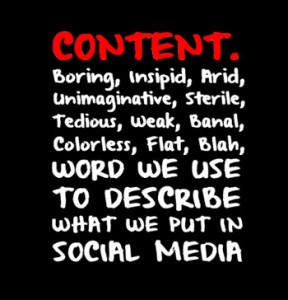By Reid Rosefelt
 Who was the person who decided that the plain vanilla word “content” was going to stand for all the stuff that gets put up on social media?
Who was the person who decided that the plain vanilla word “content” was going to stand for all the stuff that gets put up on social media?
Whoever it was should hang their head in shame.
If the history of human experience is an empty vessel, I suppose if you were a dullard you could opine that “content” is what fills it up: literature, music, movies, religion, politics, sex, joke-telling, criticism, talk show hosting, blogging, Power Point presentations, tweeting, posting, and pinteresting–it’s all content.
But I don’t think that Steven Spielberg, Kathryn Bigelow, Steve McQueen, Lorde, Vince Gilligan, Banksy, Jim Jarmusch, Louis C.K., Jane Campion, Jay-Z, Guillermo del Toro, Zadie Smith, Dave Eggers, Jony Ive, Park Chan-wook and Sara Bareilles, woke up this morning and said, “I can’t wait to start making content!” There is no poetry in “content.” There is no transcendence in “content.” There is no glory in a life devoted to content.
People who live to make beautiful things know that language is a glorious stew–spicy, subtle, sweet, sour, creamy, crunchy, familiar and foreign–so they aren’t aroused by the bland mush of words like “content.”




